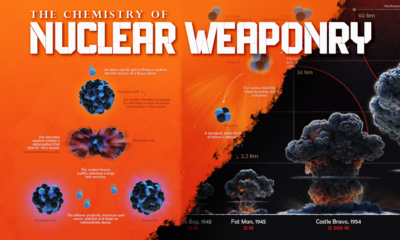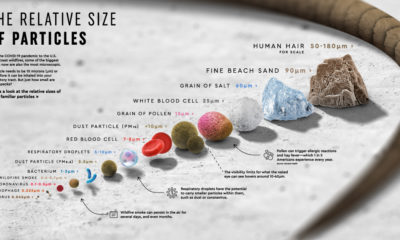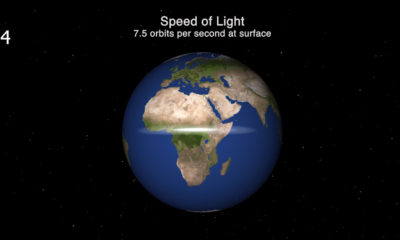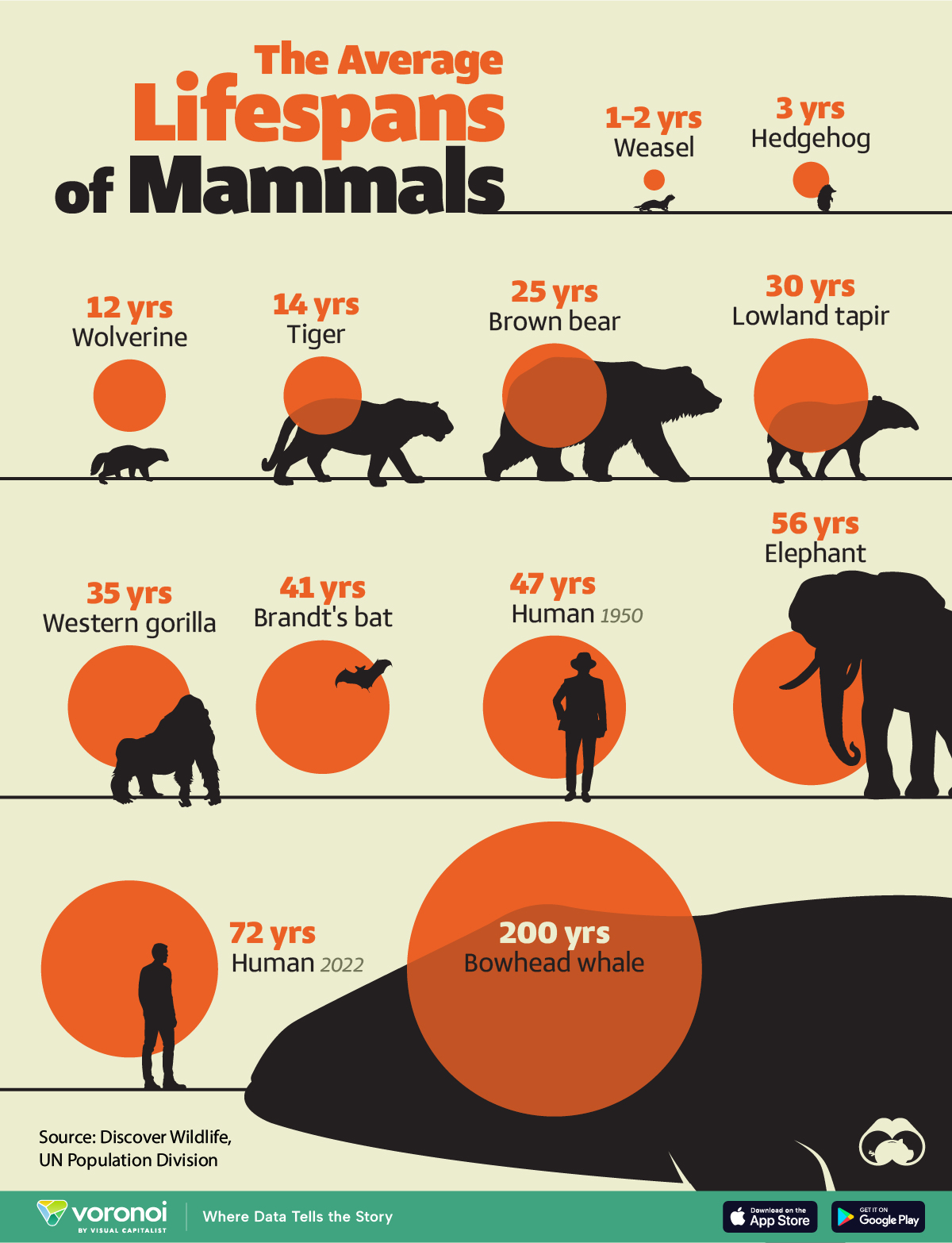Science
Visualized: Subatomic Particles and Fundamental Forces of Nature
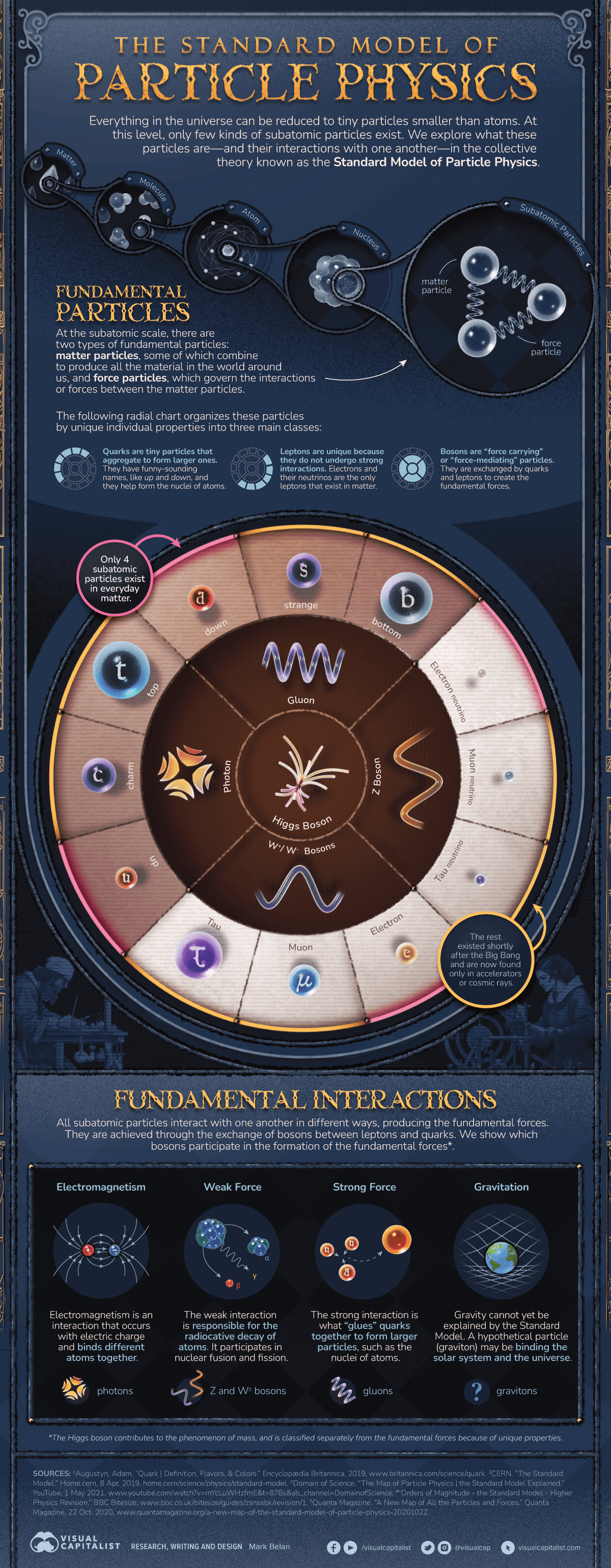
The Standard Model of Particle Physics
You may be familiar with the idea that everything in the universe is made up of matter.
If you take any object and zoom in to its molecular structure, you eventually arrive at the atom—the basic unit of matter, consisting of a nucleus composed of protons and neutrons and surrounded by electrons.
What you might not know is that there are particles that are even smaller than atoms! These are the fundamental particles, and they are the most basic, irreducible components of nature that build atoms and everything around us.
During the latter half of the 20th century, scientists identified a “family portrait” of these subatomic particles and how they interact to create forces in a collective theory known as the Standard Model of Particle Physics. We explore this model and introduce the particles that populate and govern our entire universe.
The Fundamental Subatomic Particles
There are two types of fundamental particles: matter particles, which make up atoms and everything around us, and force particles, which produce the forces that enable matter particles to interact with one another.
At the macro scale, chemical elements appear different to us based on physical properties like appearance, taste, or how they react with one another. At the atomic level, these differences are based instead on unique properties that are more technical and less obvious (i.e. mass, electrical charge, and quantum spin).
| Subatomic Particle | Type |
|---|---|
| Up (u) | Quark |
| Down (d) | Quark |
| Charm (c) | Quark |
| Strange (s) | Quark |
| Top (t) | Quark |
| Bottom (b) | Quark |
| Electron (e⁻) | Lepton |
| Electron neutrino (νe) | Lepton |
| Muon (μ⁻) | Lepton |
| Muon neutrino (νμ) | Lepton |
| Tau (τ⁻) | Lepton |
| Tau neutrino (ντ) | Lepton |
| Photon (γ) | Boson |
| Gluon (g) | Boson |
| W boson (W±) | Boson |
| Z boson (Z⁰) | Boson |
| Higgs boson (H⁰) | Boson |
The fundamental particles are categorized based on their similarities or likeness to these properties. In the Standard Model, these particles can be arranged into three major groups:
-
Quarks
Quarks are matter particles that form in groups of two or three to make larger aggregates. They come in a variety of “flavors’” and are bound tightly together due to a fundamental force called the “strong force.” This quark-binding makes up both the protons and neutrons within the nucleus of an atom.
-
Leptons
Leptons are also matter particles, but differ from quarks because they don’t participate in the strong force. Electrons that whirr around an element’s nucleus are an example of a lepton.
-
Bosons
Bosons are the force-carrying or force-mediating particles. Quarks and leptons exchange them to create the fundamental forces.
It’s interesting to note that, though 17 matter particles have been identified, today only four exist in everyday matter: the “up” and “down” quarks, the electron lepton, and the electron’s neutrino. The rest existed shortly after the Big Bang and now only exist in distant cosmic rays or in accelerators.
Breaking Down the Fundamental Forces
All subatomic particles interact with one another in different ways, producing the fundamental forces (or interactions) mentioned above. When two particles interact, they can exchange bosons between them, which is what mediates the force between the two.
- Electromagnetism is the interaction that occurs with electric charge and binds different atoms together, carried out by the exchange of photons.
- The weak force is responsible for the decay of atoms and happens due to the exchange of Z and W bosons. It participates in nuclear fusion and fission.
- The strong force is what “glues” quarks together to form larger particles, such as the nuclei of atoms. The exchange of gluons results in this force.
One force missing is gravity, which cannot yet be explained by the Standard Model. A hypothetical particle called a graviton may be the binding force that holds the solar system—and the universe—together.
The Future of the Standard Model
The Standard Model is celebrated in modern physics because of its ability to predict and explain the behavior of these particles, but it is still a work in progress.
In the 1960s, Peter Higgs theorized a missing piece of the model’s puzzle that would help explain how particles obtain mass. Dubbed the “Higgs boson” or the “God Particle,” it took a half-century until scientists at CERN in Geneva, Switzerland finally procured it in 2012.
And scientists predict there might still be one other fundamental particle, the graviton. For now, the work to explore subatomic particles and their properties, and advance modern quantum theory and mechanics, continues.
Science
Visualizing the Average Lifespans of Mammals
While smaller animals such as weasels typically live 1-2 years, larger counterparts can thrive for decades.
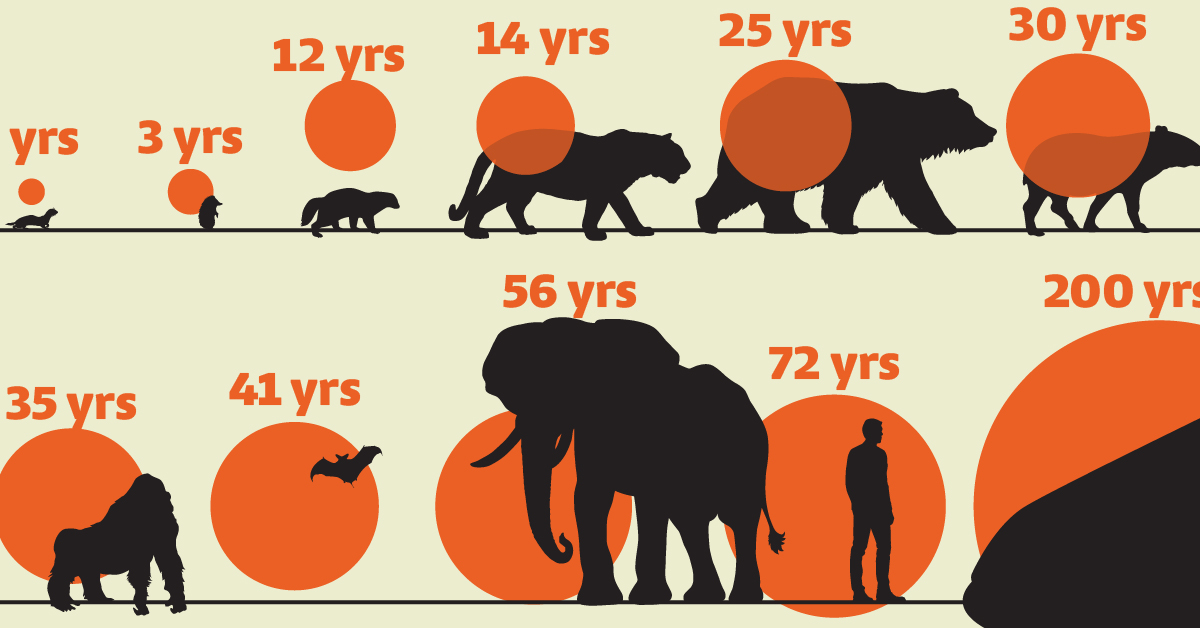
Visualizing the Average Lifespans of Mammals
This was originally posted on our Voronoi app. Download the app for free on iOS or Android and discover incredible data-driven charts from a variety of trusted sources.
Mammals, though comprising a small fraction of Earth’s creatures, hold vital ecological roles globally. They are crucial for maintaining ecosystem health through services like pollination, seed dispersal, and predator-prey dynamics.
In this visualization, we depict the average lifespans of mammals, using data from Discover Wildlife and the United Nations.
Human Lifespans on the Rise
Defined as warm-blooded creatures with hair or fur, mammals nurse their young with milk from mammary glands. While smaller animals such as weasels typically live 1-2 years, larger counterparts like elephants can thrive for decades, and bowhead whales can live for 200 years, or even longer.
| Animal | Average lifespan (years) |
|---|---|
| Weasel | 1 to 2 |
| Hedgehog | 3 |
| Wolverine | 12 |
| Tiger | 14 |
| Brown bear | 25 |
| Lowland tapir | 30 |
| Western gorilla | 35 |
| Brandt's bat | 41 |
| Humans (1950) | 47 |
| Elephant | 56 |
| Humans (2022) | 72 |
| Bowhead whale | 200 |
Notably, human lifespans have experienced a remarkable surge. According to the UN Population Division, the global average life expectancy has surged from 47 years in 1950 to 72 years in 2022, marking a 25-year increase. This is attributed to advancements in nutrition, medication, and essential resources.
However, as human longevity flourishes, it can have an adverse effect on wildlife mammal populations. To put this into numbers, over the past 100,000 years, the surge in human population has precipitated an 85% reduction in wild mammal biomass.
Today, livestock dominates 62% of the world’s mammal biomass, with humans accounting for 34%, while wild mammals comprise only 4%.
Despite a decline in mammal diversity, the total biomass of terrestrial mammals has significantly increased, expanding approximately ninefold over the past 10,000 years.
Curious to learn more about mammals? Check out this graphic that shows the biomass of all the world’s mammals.
-

 Education1 week ago
Education1 week agoHow Hard Is It to Get Into an Ivy League School?
-

 Technology2 weeks ago
Technology2 weeks agoRanked: Semiconductor Companies by Industry Revenue Share
-

 Markets2 weeks ago
Markets2 weeks agoRanked: The World’s Top Flight Routes, by Revenue
-

 Demographics2 weeks ago
Demographics2 weeks agoPopulation Projections: The World’s 6 Largest Countries in 2075
-

 Markets2 weeks ago
Markets2 weeks agoThe Top 10 States by Real GDP Growth in 2023
-

 Demographics2 weeks ago
Demographics2 weeks agoThe Smallest Gender Wage Gaps in OECD Countries
-

 Economy2 weeks ago
Economy2 weeks agoWhere U.S. Inflation Hit the Hardest in March 2024
-

 Green2 weeks ago
Green2 weeks agoTop Countries By Forest Growth Since 2001





